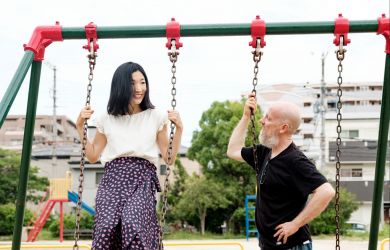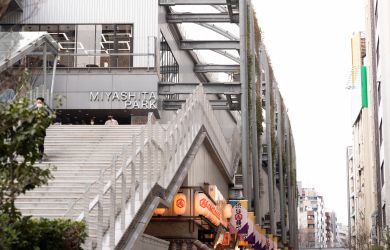
Originally published on metropolis.co.jp on June 2012

Lush green forests and mountains as far as one can see; countless streams and waterfalls with crystal water, and rustic friendly villages—this is what first sparks the interest. Then the rich heritage of the region considered the spiritual heartland of Japan gets you hooked. Kumano is situated in the southern part of the Kii Peninsula, just three hours by train or car from Nagoya or Osaka. This mountainous area is a great place to cool down and power up during Tokyo’s boiling summer.
Trails

The Kii mountain range’s sacred sites and routes received UNESCO World Heritage status in 2004. The Kumano Kodo, a network of ancient pilgrimage trails, connects these sites. The shortest, best accessible and thus most popular trail is the Nakahechi course. Walking its most popular 40km section takes two days, but it is also possible to walk only parts in half a day or in one day. The Kohechi course is rather remote and the 70km trail takes four days to traverse. Some stretches of the Ohechi course offer views of the ocean and are popular with day trippers.
Centuries ago parts of these trails were paved with stones to avoid erosion by the elements and apparently to ease the pilgrims’ journey. However, after climbing countless stone steps one is forgiven for wondering whether the real purpose was not to test the pilgrims’ spirit and endurance.
Shrines
Kumano Sanzan is the collective name given to the Three Grand Shrines of Kumano: Hongu Taisha, Nachi Taisha and Hayatama Taisha. The focal point of the Kumano Kodo trails, they are the key destinations for pilgrims and hikers alike.
Hongu Taisha was originally set on Oyunohara, a sandbank at the confluence of two rivers. It was relocated to higher ground after a devastating flood in the last century but a massive torii—the world’s largest—marks the original site. It is an impressive sight even from afar.
Nachi Falls near Nachi Taisha is one of the tallest waterfalls in Japan. Under its thunderous veil of water ascetics of old were said to have practiced cold water purification. Nowadays, purification is more likely to come from above: Kumano is famous for its copious rainfall.
If walking for long hours sounds daunting, there are other options. You can take the local bus from Hongu Taisha to Hosshinmon-oji and walk the Nakahechi trail back. This course is roughly 7km and will take 2.5 hours. You can also rent a 24-inch, battery-assisted bicycle at the Kumano Hongu Heritage Center near Hongu Taisha (¥1,500 per day). There are several recommended routes and maps available upon rental.
Onsen

For a relaxing overnight stay, three hot-spring villages are tucked away in some valleys of the Kumano Mountains near Hongu Taisha. The most distinctive is Kawayu Onsen. Wearing swimming costumes, visitors dig their own pools in the Oto riverbed, for it to fill with bubbling thermal water. One of Japan’s oldest hot spring towns, Yunomine Onsen’s main attraction is the two-person Tsuboyu bath, in a small hut above a creek, which you can rent for 30 minutes a time. If you prefer some luxury spa facilities, Wataze Onsen boasts the largest open-air hot spring pool in Western Japan.
Sustainable Tourism
Though immensely popular, Japan is not considered a leader in sustainability. The Tanabe City Kumano Tourism Bureau (www.tb-kumano.jp/en) however, works with local partners to develop grassroots tourism in the Kumano area, targeted at preserving the cultural and spiritual heritage of the region. TCKTB has been shortlisted as finalist at this year’s Tourism for Tomorrow Awards, an initiative by the World Travel and Tourism Council (WTTC). This award recognizes best practice in sustainable tourism around the world. Travelers can benefit from the varied info on the TCKTB website, as well as from their travel agency services that provide detailed English advice on planning your trip.
Inside Information
While Kumano’s Three Grand Shrines tend to get all the attention, the Kumano Kodo trails lead to other intriguing spots rarely visited by foreign tourists.
Rock Gods
Above the cityscape of Shingu rises a cliff; and at its crown is a massive boulder. This is Gotobiki Rock, a sacred object of worship. Head up to the summit to find Kamikura Shrine, one of the oldest holy spots in Kumano, pre-dating Kumano Sanzan. The shrine grounds are atmospheric, offering excellent views over Shingu and the Pacific Ocean—if you make it. It is only reached after climbing some 500 stone steps irregular in shape and size… No shortcut for lazy pilgrims here.
Trial By Fire
A date to mark in your calander is February, for Shingu’s Oto Matsuri—one of Japan’s most prominent fire festivals. Men dress up as pilgrims, purify themselves, and climb up the stone steps after sunset. Hundreds gather atop the mountain, and upon signal race down the steps at breakneck speed while carrying flaming torches. Some fathers even carry their toddler sons on their shoulders.
Finding Aikido
Aikido aficionados will have heard of Tanabe, another gateway to the trails. The second biggest city in Wakayama Prefecture is the birthplace of Morihei Ueshiba (1883-1969), founder of this Japanese martial art. Tanabe is proud of its martial arts heritage and the “Machi-Navi” audio guide will help you find, among other spots, Ueshiba’s birthplace and grave. Stop by at Tanabe’s Ogigahama beach—a great spot for a summer swim.
plenty more fish
After walking the Kumano Kodo to the Nachi Fall, catch a bus to Kii Katsura on the coast. Besides the numerous onsen in scenic settings, the town hosts an early morning fish market with a tuna auction, guaranteed to be less crowded than the one at Tsukiji Market.
No Cove
If you’re not keen on dining on dolphin or whale, you’d better stick to tuna in this region. The annual hunts at Taiji, a small town near Kii Katsura, are infamous and regularly attract protests. To steer clear altogether, focus on Wakayama’s famous umeboshi, renowned throughout the country. A box of the local pickled plums makes a great omiyage for back home.
Alena Eckelmann is JapanTourist.jp’s Wakayama and Yamagata representative





